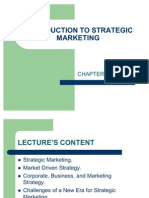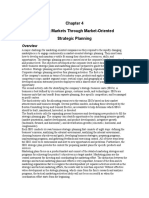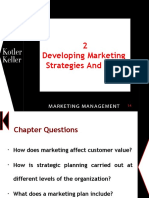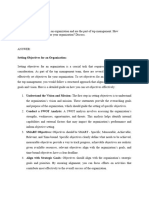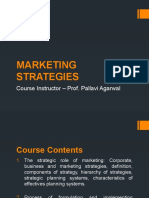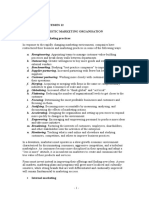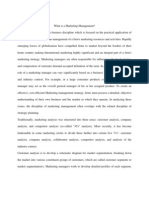0 ratings0% found this document useful (0 votes)
35 viewsBus MKTG Planning
Bus MKTG Planning
Uploaded by
Maulick JainThis document discusses strategic planning and marketing in a business-to-business context. It covers several key points:
1. Strategic planning involves coordination across multiple functions including marketing, manufacturing, R&D, logistics, and others. Effective marketing managers understand other functions' capabilities and priorities to facilitate strategy.
2. Strategies are developed at three levels - corporate, business, and functional. The marketing function contributes to assessing markets, promoting customer focus, and formulating an overall value proposition at the corporate level.
3. A successful business model ties together four components - customer interface, core strategy, strategic resources, and value network - to create a unique competitive advantage. Marketing plays a central role in strategic
Copyright:
© All Rights Reserved
Available Formats
Download as PDF, TXT or read online from Scribd
Bus MKTG Planning
Bus MKTG Planning
Uploaded by
Maulick Jain0 ratings0% found this document useful (0 votes)
35 views62 pagesThis document discusses strategic planning and marketing in a business-to-business context. It covers several key points:
1. Strategic planning involves coordination across multiple functions including marketing, manufacturing, R&D, logistics, and others. Effective marketing managers understand other functions' capabilities and priorities to facilitate strategy.
2. Strategies are developed at three levels - corporate, business, and functional. The marketing function contributes to assessing markets, promoting customer focus, and formulating an overall value proposition at the corporate level.
3. A successful business model ties together four components - customer interface, core strategy, strategic resources, and value network - to create a unique competitive advantage. Marketing plays a central role in strategic
Original Description:
It is all about how to make marketing plan for a business
Original Title
Bus Mktg Planning
Copyright
© © All Rights Reserved
Available Formats
PDF, TXT or read online from Scribd
Share this document
Did you find this document useful?
Is this content inappropriate?
This document discusses strategic planning and marketing in a business-to-business context. It covers several key points:
1. Strategic planning involves coordination across multiple functions including marketing, manufacturing, R&D, logistics, and others. Effective marketing managers understand other functions' capabilities and priorities to facilitate strategy.
2. Strategies are developed at three levels - corporate, business, and functional. The marketing function contributes to assessing markets, promoting customer focus, and formulating an overall value proposition at the corporate level.
3. A successful business model ties together four components - customer interface, core strategy, strategic resources, and value network - to create a unique competitive advantage. Marketing plays a central role in strategic
Copyright:
© All Rights Reserved
Available Formats
Download as PDF, TXT or read online from Scribd
Download as pdf or txt
0 ratings0% found this document useful (0 votes)
35 views62 pagesBus MKTG Planning
Bus MKTG Planning
Uploaded by
Maulick JainThis document discusses strategic planning and marketing in a business-to-business context. It covers several key points:
1. Strategic planning involves coordination across multiple functions including marketing, manufacturing, R&D, logistics, and others. Effective marketing managers understand other functions' capabilities and priorities to facilitate strategy.
2. Strategies are developed at three levels - corporate, business, and functional. The marketing function contributes to assessing markets, promoting customer focus, and formulating an overall value proposition at the corporate level.
3. A successful business model ties together four components - customer interface, core strategy, strategic resources, and value network - to create a unique competitive advantage. Marketing plays a central role in strategic
Copyright:
© All Rights Reserved
Available Formats
Download as PDF, TXT or read online from Scribd
Download as pdf or txt
You are on page 1of 62
PowerPoint by:
Ray A. DeCormier, Ph.D.
Central Connecticut State University
Chapter 5:
Business Marketing
Planning: Strategic
Perspectives
Chapter Topics
1. Marketings strategic role in corporate strategy
development
2. The multifunctional nature of business marketing
decision-making
3. Components of a business model that can be
converted into superior positions of advantage in the
business market
4. A valuable framework for detailing the processes and
systems that drive strategy success
New Strategies
New strategies come from new ideas
New ideas often come from new voices
To meet both domestic and foreign
competition, B2B firms are recognizing the vital
role of marketing in developing and
implementing successful strategies
Effective Strategies
Effective strategies share a:
A. Responsiveness to market needs
B. Ability to exploit the organizations special
competencies
C. Ability to make valid assumptions about
environmental trends
D. Ability to take advantage of competitive behavior
E. Realistic basis for securing and sustaining a
competitive advantage
Market-driven organizations are:
Centered on customers
Take an outside-in view of strategy
Demonstrate an ability to sense
market trends ahead of their
competitors
Market-Driven Organizations
Hierarchy of Strategies 3 parts
Corporate Strategy
Business-Level Strategy
Functional Strategy
Hierarchy of Strategies Part 1
Corporate Strategy
What businesses are we in?
What are our core competencies?
How should we allocate resources?
What businesses should we be in?
Corporate Strategy
At this level, the role of Marketing is to:
a) Assess market attractiveness and
competitive effectiveness of the firm
b) Promote customer orientation to
management
c) Formulate the companys overall value
proposition that is marketed to the
customer, management and employees
Marketing Strategy to Corporate
An important role for marketing
management is to make the firm
understand the Customer is King
and advocate a set of values and
beliefs that put the customer first in
the firms decision-making process.
Hierarchy of Strategies Part 2
Business-Level Strategy
How do we compete in a given industry?
How should we position ourselves against
competitors?
Business-Level Strategy
The focus is on how firms compete in a
given industry.
Competition is not between large corporations. It
is between individual business units (SBUs) that
compete in specific markets. Each SBU needs to
develops its own business and marketing plans
to answer:
How can we compete?
How and what is the most efficient way to get
to the market?
What are our distinctive skills?
Hierarchy of Strategies Part 3
Functional Strategy
How can we allocate resources to
most efficiently and effectively
support business-level strategies?
How can we use resources to meet
the firms objectives within a
specific product market?
The interplay between the three levels of
strategic formulation:
1. Cuts across functional areas
2. Involves issues related to long term
objectives
3. Involves allocating resources across SBUs
and/or product markets
4. Includes decisions about the direction of
corporate strategy, application of
technology and choice of alliance partners
Strategic Decision
1. Process involves active participation of several
functional groups with differing opinions about:
a. Appropriateness of certain strategies
b. Corporate goals
2. Altering strategic goals can cause friction
between them.
3. However, strategic decision-making represents
a bargaining process between competing
functional factions.
The Game
There are a number of players within an organization
that want to change strategy to further their interests.
Certain managers feel their functional areas belong to
them (turf) and if anyone intrudes by changing the
strategy, they are stepping over their bounds.
Further, various groups possess different philosophies,
beliefs and incentives resulting in different thought-
worlds.
Thus, each subculture has a different agenda.
The bargaining process for arriving at a mutually
agreeable strategic decision between these competing
forces represent the game.
16
Collective Action Perspective of Strategy Formulation Process
Corporate Progress Requires a
Meeting of the Minds
Successful cross-functional connections
occur when turf wars, thought-worlds, and
other various interest groups come together
and develop a workable strategy to deal
with the competitive world.
In order for this to occur, the marketing
group needs to be sensitive toand
connect withthese stakeholders.
Cross-Functional Connections Explore Interrelationships
between Marketing and Four Business Functions
B2B TOP PERFORMERS
Marketing managers who know how to get the
job done (i.e., facilitate negotiations across
functional areas) possess certain characteristics:
1. Responsive & timely
2. Perspective-taking ability to understand and
anticipate other functional managers priorities
3. Open, frequent and high quality
communication style
4. Their word is their bond and follow through
5. Able to develop a strong network
19
Successful marketing managers know
how to integrate functional areas.
They:
1. Understand their capabilities
2. Capitalize on their strengths
3. Facilitate strategies that are responsive
to customer needs
Successful marketing managers assume
a central role in strategy
implementation.
Inter-Functional Involvement in Marketing Decision Making:
An Illustrative Responsibility Chart
Decision areas Marketing Manufacturing R&D Logistics Tech.
Services
SBU
Manager
Corp. Level
Manager
Product
Design specifications
Performance character.
Reliability
Price
List/Discount
Tech. Services
Customer training
Logistics
Inventory
Customer service level
Sales Force
Training
Advertising
Message development
Channel
Selection
21
Organizational Function
Decision role: R=Responsibility; A=Approval; C=Consult; M=Implement; I=Inform,
X=No Role
Vocabulary
Roles in Strategic Decision Making
Participants in strategic decision making may assume the
following roles:
Responsible (R) - Manager takes initiative, analyzes
situation, develops alternatives, consults with others,
make initial recommendation, & facilitates approval of
decision
Approve (A) - Manager accepts or rejects decisions
Consult (C) - Manager offers input
Implement (M) - Manager is accountable for
implementing decision
Inform (I) - Manager is informed of the decision
Marketing Strategy Center (MSC)
Representatives may assume more than
one role
Roles evolve during the marketing
strategy development process
Composition of the MSC is not strictly
prescribed by the organization chart
MSC share certain parallels with the
buying center
One challenge for the business marketer is to
minimize interdepartmental conflict.
Conflicts are motivated by personal and
organizational goals.
Organizational objectives may be different for
different functional areas. (Example: Various
functional areas are rewarded differently.)
Managing conflict, promoting cooperation,
developing and coordinating strategy is a
fundamental responsibility for marketing managers.
Strategy Success
For a strategy to succeed:
Each firm needs to have a business
concept that separates them apart
from their competition.
There are 4 components:
1. Customer Interface
2. Core Strategy
3. Strategic Resources
4. Value Network
Refer to Figure 5.2
Major business concept components are tied together by
three important bridge elements: customer benefits,
configuration, and company boundaries.
CUSTOMER INTERFACE
Fulfillment & Support
Information & Insight
Relationship Dynamics
Pricing Structure
CORE STRATEGY
Business Mission
Product/Market Scope
Basis for Differentiation
STRATEGIC RESOURCES
Core Competencies
Strategic Assets
Core Processes
VALUE NETWORK
Suppliers
Partners
Coalitions
EFFICIENT / UNIQUE / FIT / PROFIT BOOSTERS
Fig. 5.2 Components of a
Business Model: Bridges to Profits
Fulfillment
& Support
Information
& Insight
Relationship
Dynamics
Pricing
Structure
1. Customer Interface
1. CUSTOMER INTERFACE
1. Fulfillment & Support They are the channels a
firm uses to reach and support customers.
2. Information & Insight Involves the capture of
knowledge from customers and uses it to provide
enhanced value to customers.
3. Relationship Dynamics Involves the dyadic
nature of the buy/sell relationship in order to
understand customer expectations so it can exceed
them, increase the affiliation and lower
competitive influences.
4. Pricing Structure Employs a pricing policy and
structure that enhances profits but not at the
expense of curtailing business.
Major business concept components are tied together by
three important bridge elements: customer benefits,
configuration, and company boundaries.
CUSTOMER INTERFACE
Fulfillment & Support
Information & Insight
Relationship Dynamics
Pricing Structure
CORE STRATEGY
Business Mission
Product/Market Scope
Basis for Differentiation
STRATEGIC RESOURCES
Core Competencies
Strategic Assets
Core Processes
VALUE NETWORK
Suppliers
Partners
Coalitions
EFFICIENT / UNIQUE / FIT / PROFIT BOOSTERS
Fig. 5.2 Components of a
Business Model: Bridges to Profits
The business mission describes overall strategic
objective, sets course direction, and defines
performance criteria to measure progress.
Product/market scope defines where firm
competes.
Basis for differentiation captures essence of how
firm competes differently than its rivals do.
Core Strategy Three Elements
Differentiation of Products and Services
A business is differentiated when its value-
adding activities are perceived as superior and
profitable.
Value-added features need to motivate
customers to pay a higher premium than the
cost of superior performance.
Provide superior performance through:
Speed
Responsiveness to complex orders
Customized to solve customer problems
Provide superior quality by:
Reducing customer costs
Improving performance
Offer innovative product features that employ
new technologies
Major business concept components are tied together by
three important bridge elements: customer benefits,
configuration, and company boundaries.
CUSTOMER INTERFACE
Fulfillment & Support
Information & Insight
Relationship Dynamics
Pricing Structure
CORE STRATEGY
Business Mission
Product/Market Scope
Basis for Differentiation
STRATEGIC RESOURCES
Core Competencies
Strategic Assets
Core Processes
VALUE NETWORK
Suppliers
Partners
Coalitions
EFFICIENT / UNIQUE / FIT / PROFIT BOOSTERS
Fig. 5.2 Components of a
Business Model: Bridges to Profits
Competitive Advantage
Employing superior strategic resources
and skills can gain a competitive
advantage.
Core competencies are set of skills,
systems, and technologies that create
uniquely high value for customers.
Strategic assets are more tangible
requirements for advantage; includes
brands, customer data, distribution
coverage, patents.
Core processes are methodologies and
routines that companies use to transform
competencies, assets, and other inputs into
value for customers.
Major business concept components are tied together by
three important bridge elements: customer benefits,
configuration, and company boundaries.
CUSTOMER INTERFACE
Fulfillment & Support
Information & Insight
Relationship Dynamics
Pricing Structure
CORE STRATEGY
Business Mission
Product/Market Scope
Basis for Differentiation
STRATEGIC RESOURCES
Core Competencies
Strategic Assets
Core Processes
VALUE NETWORK
Suppliers
Partners
Coalitions
EFFICIENT / UNIQUE / FIT / PROFIT BOOSTERS
Fig. 5.2 Components of a
Business Model: Bridges to Profits
Value Network
A value network includes those who complement and
enrich the organization.
Do we have good relations with suppliers,
partners, vendors and other supporters?
Can we partner with others in such a way that we
can use their assets as if they were our own?
Example: Using UPS as shipping service
Competitive positioning is about being
different and competing in a distinct way
by using a unique mix of customer values.
Michael Porter states there are six
fundamentals principles that a company
should employ for establishing and
maintaining a distinct strategic position.
Michael Porter Asks: What is Strategic Positioning?
Michael Porter & Strategic Positioning
Right goal: Superior long term ROI instead of
performance goals (i.e., % share market)
Create and deliver a good customer value proposition
Create a distinctive value chain by offering or
performing similar features but in a different way
Accept trade-offs: You cant be everything to everyone,
therefore give up some things and reinforce others that
enhance the distinctions
Emphasize those element that facilitate the strategic fit
and reinforce them
Continuity of direction means to define a distinctive
value proposition and build strong customer relations by
staying consistent to that plan
Building the Strategic Plan
Companies need to do many things well.
However, underperformance is caused by a breakdown
between strategy and operations.
Kaplan & Norton contend that successful strategic
execution involves two rules:
a. Understand the Management cycle that links
strategy and operations, and
b. Know what tools to apply at each stage of the cycle.
This system allows
management to plan,
coordinate and monitor
the links between
strategy and operations.
The Management System
The Management System
Involves 5 stages:
1. Strategy development
2. Translate strategy into objectives
3. Design key processes
4. Monitor performance
5. Adapt the strategy
2 Key tools for successful strategy implementation are:
1. Balanced Scorecard
2. Strategy Map
Balanced Scorecard
Developed by Kaplan and Norton.
We know measures are central to any
strategy.
The Balanced Scorecard is a comprehensive
system for converting a companys vision
and strategy into a tightly connected set of
performance measures.
Balanced Scorecard
Examines the performance of a business
unit from four perspectives:
1. Financial
2. Customer
3. Internal Business
4. Learning and growth
The Balanced Scorecard - Translating Strategy Into
Operational Terms
4. Learning and Growth Perspective
3. Internal Process Perspective
1. Financial Perspective
Productivity
Long-Term
Shareholder
Value
Revenue
Growth
2. Customer Perspective
Product/Service Attributes Relationship Image
Price Quality Time Function Partnership Brand
Manage
Operations
Manage
Customers
Manage
Innovation
Manage
Regulatory
and Social
Processes
Human
Capital
Information
Capital
Organization
Capital
+ +
Cause-and-Effect Relationships
Defines the chain of logic by which
intangible assets will be
transformed to tangible value.
Customer Value Proposition
Clarifies conditions that create
value for the customer.
Value-Creating Processes
Defines processes that transform
intangible assets into customer
and financial outcomes.
Clustering Assets and Activities
Defines intangible assets to be
aligned and integrated to create
value.
Cause & Effect Relationship defines the logic
that transforms intangible assets into
tangible assets.
Consideration is give to:
1. Productivity
2. Long-term shareholder value
3. Revenue growth
Balanced Scorecard seeks to match financial
objectives with business units growth and
other life cycle stages.
Growth stage:
Operation: This stage is where the company needs
to commit resources for new product or service.
Financial objectives:
Know sales growth rate by segment
Know % of revenue from new product, services and
customers
Sustain Stage:
Operation: This stage represents majority of
business where the strategy is to maintain and
grow slowly.
Financial objectives:
Focus on share of target customers and account
Know customer and product line profitability
Harvest Stage:
Mature SBUs or products
Operations: Provide only enough investment to
maintain product equipment and capabilities.
Financial Objectives:
Goal is payback
Know customer and product-line profitability
The Balanced Scorecard - Translating Strategy Into
Operational Terms
4. Learning and Growth Perspective
3. Internal Process Perspective
1. Financial Perspective
Productivity
Long-Term
Shareholder
Value
Revenue
Growth
2. Customer Perspective
Product/Service Attributes Relationship Image
Price Quality Time Function Partnership Brand
Manage
Operations
Manage
Customers
Manage
Innovation
Manage
Regulatory
and Social
Processes
Human
Capital
Information
Capital
Organization
Capital
+ +
Cause-and-Effect Relationships
Defines the chain of logic by which
intangible assets will be
transformed to tangible value.
Customer Value Proposition
Clarifies conditions that create
value for the customer.
Value-Creating Processes
Defines processes that transform
intangible assets into customer
and financial outcomes.
Clustering Assets and Activities
Defines intangible assets to be
aligned and integrated to create
value.
2. CUSTOMER PERSPECTIVE
Clarifies conditions that create
customer value
Take into consideration:
1. Product/Service attributes (price, quality,
time & function)
2. Relationships (partnerships)
3. Image (brand)
2. CUSTOMER PERSPECTIVE: CORE MEASURES
Market Share Proportion of business in a particular market by:
a. % share of market
b. Total number of customers
c. Dollars spent or unit volume sold
Customer Acquisition Tracks in absolute or relative terms rate at which SBU
attracts and/or wins new customers
Customer Retention Tracks in absolute or relative terms rate at which SBU
retains new customers
Customer Satisfaction Matches the satisfaction level of customers on specific
performance criteria such as quality, service, delivery,
reliability, etc.
Customer Profitability Assesses the net profit on each customer, or a segment,
after deducting unique expenses allocated to support
that customer or segment
52
3. Internal Process Perspective
This highlights the value-creating processes
that define the other processes that will
transform intangible assets into tangible
assets.
It considers:
1. Operations management
2. Customer management
3. Innovation management
4. Regulatory & social processes management
Key Value Propositions & Customer Strategy The Focus of Internal Business Processes
Operations Management Customer Relationship Management Innovation Management
Low Total Cost Strategy Highly Efficient Operating Ease of Customer Access Seek Process Innovations
Processes Superb Post-Sales Service Gain Scale Economies
Efficient, Timely Distribution
Product Leadership Flexible Manufacturing Capture Customer Ideas for Disciplined, High-Performance
Strategy Processes New Offering Product Development
Rapid Introduction of Educate Customers about Complex First-to-Market
New Products New Products/Services
Complete Customer Deliver Broad Product/ Create Customized Solutions Identify New Opportunities
Solutions Strategy Service Line for Customers to Serve Customers
Create Network of Suppliers Build Strong Customer Anticipate Future Customer
for Extended Product/ Relationships Needs
Service Capabilities Develop Customer Knowledge
Lock-in Provide Capacity for Create Awareness Develop and Enhance
Strategies Proprietary Product/ Influence Switching Costs of Proprietary Product
Service Existing and Potential Increase Breadth/
Reliable Access and Customers Applications of
Standard
Ease of Use
Source: Adapted from Robert S. Kaplan and David P. Norton, Strategy Maps: Converting Intangible Assets into Tangible Outcomes (Boston: Harvard
Business School Publishing Corporation, 2004), pp. 322-344.
3. Aligning Internal Business Processes
The Balanced Scorecard - Translating Strategy Into
Operational Terms
4. Learning and Growth Perspective
3. Internal Process Perspective
1. Financial Perspective
Productivity
Long-Term
Shareholder
Value
Revenue
Growth
2. Customer Perspective
Product/Service Attributes Relationship Image
Price Quality Time Function Partnership Brand
Manage
Operations
Manage
Customers
Manage
Innovation
Manage
Regulatory
and Social
Processes
Human
Capital
Information
Capital
Organization
Capital
+ +
Cause-and-Effect Relationships
Defines the chain of logic by which
intangible assets will be
transformed to tangible value.
Customer Value Proposition
Clarifies conditions that create
value for the customer.
Value-Creating Processes
Defines processes that transform
intangible assets into customer
and financial outcomes.
Clustering Assets and Activities
Defines intangible assets to be
aligned and integrated to create
value.
4. Learning & Growth
Intangible assets must be aligned to long term
strategy to achieve long term growth.
Intangible assets represent the capabilities of
the companys employees to satisfy customer
needs.
They include:
Human capital
Information capital
Organization capital
4. Learning & Growth (continued)
To implement strategy, the organization needs:
1. Human Capital: Availability of employees
with skills & talent
2. Information Capital: Availability of
information systems and infrastructure
3. Organization Capital: The culture,
leadership, incentives and teamwork
Benefit of the Balanced Scorecard
The Balanced Scorecard helps align the
firms tangible and intangible assets with
the organizations strategic goals.
See next frame:
3. Aligning Internal Business Processes
Key Value Propositions & Customer Strategy The Focus of Internal Business Processes
Operations Management Customer Relationship Management Innovation Management
Low Total Cost Strategy Highly Efficient Operating Ease of Customer Access Seek Process Innovations
Processes Superb Post-Sales Service Gain Scale Economies
Efficient, Timely Distribution
Product Leadership Flexible Manufacturing Capture Customer Ideas for Disciplined, High-Performance
Strategy Processes New Offering Product Development
Rapid Introduction of Educate Customers about Complex First-to-Market
New Products New Products/Services
Complete Customer Deliver Broad Product/ Create Customized Solutions Identify New Opportunities
Solutions Strategy Service Line for Customers to Serve Customers
Create Network of Suppliers Build Strong Customer Anticipate Future Customer
for Extended Product/ Relationships Needs
Service Capabilities Develop Customer Knowledge
Lock-in Provide Capacity for Create Awareness Develop and Enhance
Strategies Proprietary Product/ Influence Switching Costs of Proprietary Product
Service Existing and Potential Increase Breadth/
Reliable Access and Customers Applications of Standard
Ease of Use
Source: Adapted from Robert S. Kaplan and David P. Norton, Strategy Maps: Converting Intangible Assets into Tangible Outcomes (Boston: Harvard
Business School Publishing Corporation, 2004), pp. 322-344.
3. Aligning Internal Business Processes
Strategy Map
The cause & effect components of the Balanced
Scorecard template is transformed into visual
model called the strategy map.
The strategy map allows the company to describe
and illustrate its:
Objectives, initiatives & targets
Measurements used to assess performance
Linkages which are the foundation of the strategic
direction
Strategy Map
The next frame illustrates a firms strategic map for
pursuing a product leadership strategy.
To start the company emphasize:
Productivity strategy &
Revenue Growth strategy
Refer to Strategy Map Template
Balanced Scorecard
Strategy Map Template: Product Leadership
Financial
Perspective
Customer
Perspective
Internal
Perspective
Learning and
Growth
Perspective
Products and Services That Expand Existing Performance Boundaries into the Highly Desirable
A Capable, Motivated and Technologically Enabled Workforce
Long-Term Shareholder Value
Manage Total Life-Cycle
Product Costs
Revenues from
New Products
Gross Margins:
New Products
Productivity Strategy Revenue Growth Strategy
High-Performance Products: Smaller,
Faster, Lighter, Cooler, More
Accurate, More Storage, Brighter
First to market
New Customer
Segments
Operations Management Customer Management Innovation Regulatory and Social
Flexible
Robust
Processes
Rapid
Introduction
of New
Products
Supply
Capacity
for Rapid
Growth
In-line
Experimentation
and
Improvement
Educate
Customers about
Complex New
Products/Services
Capture Customer
Ideas for New
Products/Services
Disciplined,
High-Performance
Product
Development
Product
Development
Time: From Idea
to Market
Minimize
Product Liability
And
Environmental
Impact
Contribute to
Communities
Find, Motivate, Grow, and Retain the Best Talent
Human Capital Information Capital Organization Capital
Deep
Functional
Expertise
Creative, Versatile
Employees: Cross-
functional Teamwork
Virtual Product
Prototyping and
Simulation
Computer-Aided
Design and
Manufacturing
(CAD/CAM)
Creativity,
Innovation
You might also like
- Chapter 3: Strategic Planning and MarketingDocument12 pagesChapter 3: Strategic Planning and MarketingAnthony ClemonsNo ratings yet
- Module 1 - Developing Marketing Strategies and PlansDocument13 pagesModule 1 - Developing Marketing Strategies and PlansAbigail GatmaitanNo ratings yet
- Marketing Management Concepts and Tools: A Simple IntroductionFrom EverandMarketing Management Concepts and Tools: A Simple IntroductionRating: 3.5 out of 5 stars3.5/5 (8)
- INTRODUCTION TO STRATEGIC MARKETING (Chapter 1)Document41 pagesINTRODUCTION TO STRATEGIC MARKETING (Chapter 1)Wan Muhammad Abdul Hakim82% (11)
- ch05 Bus MKTG PlanningDocument62 pagesch05 Bus MKTG PlanningKomal KhatterNo ratings yet
- Business Marketing Planning: Strategic PerspectivesDocument14 pagesBusiness Marketing Planning: Strategic PerspectivesAnushkaSinhaNo ratings yet
- CH1 MKT STGDocument5 pagesCH1 MKT STGsaraNo ratings yet
- Session 12 - Strategic Business PerspectivesDocument15 pagesSession 12 - Strategic Business PerspectivesRutwik PatilNo ratings yet
- Chapter 2Document11 pagesChapter 2Sergio SolarteNo ratings yet
- 2016.06.01 - Lecture 2 - Summer School Principles of Marketing - Chapter 2Document28 pages2016.06.01 - Lecture 2 - Summer School Principles of Marketing - Chapter 2nipoNo ratings yet
- Semester: 113 - Fall 2011Document7 pagesSemester: 113 - Fall 2011Manju MohanNo ratings yet
- 01 MarketingDocument24 pages01 MarketingyeorkyNo ratings yet
- Strategic Marketing 10th Edition Cravens Solutions Manual 1Document36 pagesStrategic Marketing 10th Edition Cravens Solutions Manual 1guymontgomerygpbocfyamt100% (43)
- Strategic Marketing 10th Edition Cravens Solutions Manual 1Document74 pagesStrategic Marketing 10th Edition Cravens Solutions Manual 1michael100% (46)
- Unit 3 - Strategic Direction & Strategy FormulationDocument43 pagesUnit 3 - Strategic Direction & Strategy Formulationnishant2024No ratings yet
- Chapter 2 - Capturing Marketing InsightsDocument14 pagesChapter 2 - Capturing Marketing InsightsHusain Sulemani100% (1)
- Winning Markets Through Market-Oriented Strategic PlanningDocument8 pagesWinning Markets Through Market-Oriented Strategic PlanningRodrigoNo ratings yet
- 2 Developing Marketing Strategies and PlansDocument89 pages2 Developing Marketing Strategies and PlansOssama FatehyNo ratings yet
- SM-Study Pack - Chapter S 1-3Document74 pagesSM-Study Pack - Chapter S 1-3Danish KumarNo ratings yet
- Answer To ASSIGNMENT 012Document15 pagesAnswer To ASSIGNMENT 012tukuryusuf787No ratings yet
- Marketing For Engineers CH 2Document80 pagesMarketing For Engineers CH 2karim kobeissiNo ratings yet
- Marketing StrategiesDocument20 pagesMarketing StrategiesDr. KANAGALURU SAI KUMARNo ratings yet
- Marketing Menadzment SkriptaDocument27 pagesMarketing Menadzment SkriptaВиктор УнгиновићNo ratings yet
- Topic 3 DEVELOPING MARKETING STRATEGIES AND PLANSDocument15 pagesTopic 3 DEVELOPING MARKETING STRATEGIES AND PLANSmina dangarangNo ratings yet
- Chapter 2. Company and Marketing Strategy - Partnering To Build Customer RelationshipsDocument10 pagesChapter 2. Company and Marketing Strategy - Partnering To Build Customer RelationshipsAnna Pante100% (1)
- Business Marketing Planning: Strategic PerspectivesDocument35 pagesBusiness Marketing Planning: Strategic PerspectivesKiran KumarNo ratings yet
- Assignment 1 - Marketing ManagementDocument9 pagesAssignment 1 - Marketing Managementwidi tigustiNo ratings yet
- Chapter 6 FinalDocument12 pagesChapter 6 FinalGolamMowlaShuvoNo ratings yet
- AdvantagesDocument5 pagesAdvantagesMergierose DalgoNo ratings yet
- Kotler Pom16e Inppt 02Document47 pagesKotler Pom16e Inppt 02Nashran Harith Nazree100% (1)
- Marketing Planning - Strategic Planning in MarketingDocument11 pagesMarketing Planning - Strategic Planning in MarketingAtanas SerbezovNo ratings yet
- A Study On The Marketing ProcessDocument23 pagesA Study On The Marketing Processsammii691No ratings yet
- MS Unit 4 Directional Policy MatrixDocument68 pagesMS Unit 4 Directional Policy MatrixDeshna KocharNo ratings yet
- Chapter 2 SummaryDocument3 pagesChapter 2 SummaryeudamnboredNo ratings yet
- MP 12Document8 pagesMP 12Pei Xin YauNo ratings yet
- Lesson 3 What Is Strategic ManagementDocument14 pagesLesson 3 What Is Strategic ManagementJanica IntegroNo ratings yet
- Developing Marketing Strategies and Plans CH 2Document31 pagesDeveloping Marketing Strategies and Plans CH 2ontheline4No ratings yet
- Chapter 2 BookDocument3 pagesChapter 2 BookAziz IskandarovNo ratings yet
- FinalDocument11 pagesFinalmannu456No ratings yet
- Strategic MGMT ch-4Document8 pagesStrategic MGMT ch-4Redela SemanNo ratings yet
- Chapter 7 Developing A Business StrategyDocument6 pagesChapter 7 Developing A Business StrategySarah Girgis100% (1)
- Developing Marketing Strategies and Plans: Learning ObjectivesDocument16 pagesDeveloping Marketing Strategies and Plans: Learning ObjectivesMalikNo ratings yet
- Midterm Strategy FormulationDocument17 pagesMidterm Strategy FormulationEricca Joyce AndradaNo ratings yet
- Marketing Plan of The ClientDocument5 pagesMarketing Plan of The ClientMOHIT GUPTANo ratings yet
- Chapter - OneDocument46 pagesChapter - OneAshaduzzaman Pinak100% (1)
- Notes To Accompany The Business Development Process Model For Micro and Small Businesses.Document5 pagesNotes To Accompany The Business Development Process Model For Micro and Small Businesses.Chris HawcroftNo ratings yet
- Chapter 04 Channel Strat Devt DesignDocument12 pagesChapter 04 Channel Strat Devt DesignAj CapungganNo ratings yet
- Chapter 2: Developing Marketing Strategies and PlansDocument29 pagesChapter 2: Developing Marketing Strategies and PlansSyed Seerat Ali ZaidiNo ratings yet
- Module 1 - Objectives And: Welcome To Module 1 of Principles of Marketing! During This Course, You Will HaveDocument6 pagesModule 1 - Objectives And: Welcome To Module 1 of Principles of Marketing! During This Course, You Will HaveMariz FamarinNo ratings yet
- Chap 1 StrategyDocument23 pagesChap 1 Strategymilionabera06No ratings yet
- Strategic SolvedDocument20 pagesStrategic SolvedMoin KureshiNo ratings yet
- Chapter 2 - Company & Marketing Strategy (PART 1)Document38 pagesChapter 2 - Company & Marketing Strategy (PART 1)Abdul GhaniNo ratings yet
- Assignment 02Document41 pagesAssignment 02Faryal ShahidNo ratings yet
- Marketing Strategies and PlansDocument10 pagesMarketing Strategies and PlansMhyr Pielago CambaNo ratings yet
- Strategies For Business & Group MeetingsDocument8 pagesStrategies For Business & Group Meetingsoreilybrownsworthwbe.ha8.85.8No ratings yet
- Strategic Planning - The Process of Developing and Maintaining A Strategic Fit Between The Organization'sDocument17 pagesStrategic Planning - The Process of Developing and Maintaining A Strategic Fit Between The Organization'shana hansNo ratings yet
- What Is A Marketing ManagementDocument6 pagesWhat Is A Marketing ManagementkensihimursNo ratings yet
- 22 - Creating Enterprise-Wide Go-To-Market CapabilitiesDocument3 pages22 - Creating Enterprise-Wide Go-To-Market CapabilitiesDlx AreaOneNo ratings yet
- MS Module 1Document124 pagesMS Module 1Saidas nair100% (1)
- Branding Strategy Learning UnitDocument100 pagesBranding Strategy Learning UnitethancfisherNo ratings yet



